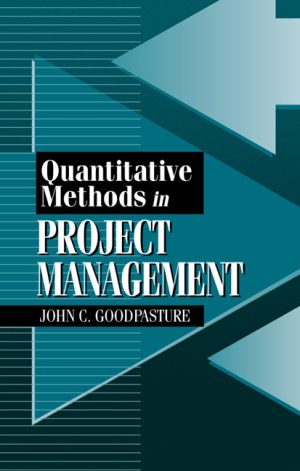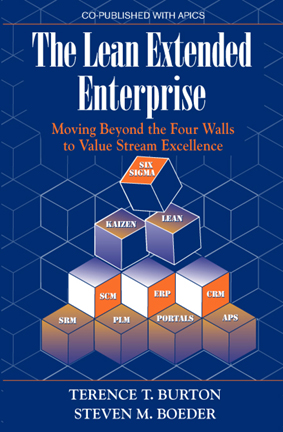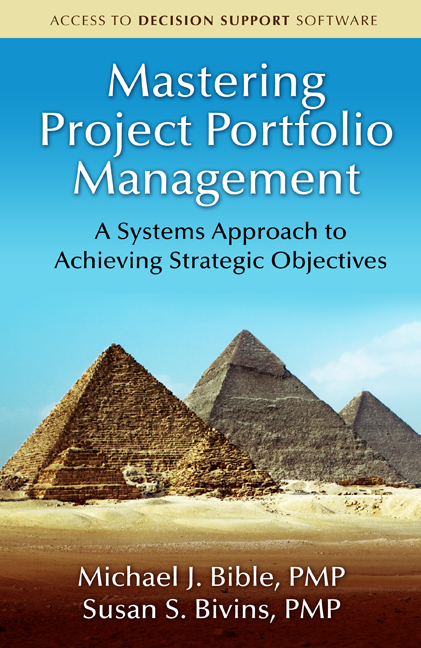Mastering Project Portfolio Management
$79.95
A Systems Approach to Achieving Strategic Objectives
By Michael J. Bible, MSPM, PMP, and Susan S. Bivins, MSPM, PMP
Hardcover, 7×10, 360 pages
ISBN: 978-1-60427-066-2
September 2011
LEARN & EARN: Get 7.6 PDUs in the PMI skill areas of Technical and Strategic or Business Management Skills
Description
Official reference material for the Portfolio Management Professional (PfMP)SM Credential Examination
This unique text provides a holistic view of project portfolio management (PPM) that includes people, process, tools, and techniques that work synergistically within the organization to produce portfolio decisions with the best chance of success. It illustrates the entire PPM process from strategic planning through portfolio evaluation and adjustment, including prioritizing objectives, identifying and evaluating candidate projects, selecting optimal portfolios using portfolio analysis, establishing project and portfolio performance metrics, measuring portfolio performance, and project portfolio governance.
Rather than just an abstract discussion, Mastering Project Portfolio Management simulates real-world portfolio management through sample scenarios demonstrating advanced decision-making techniques and the use of decision-making software that readers are given access to. This book guides readers step-by-step through the entire project portfolio management process and is ideal for corporate and government training programs and as a primary text for graduate level academic courses.
Key Features
- Includes limited license access to web-based and desktop decision-support software with a resource aligner module for structuring Analytic Hierarchy Process (AHP) models, prioritizing objectives and alternatives, and optimizing the portfolio
- Shows how to effectively design, develop, implement, and manage a tailored project portfolio process without great time or expense by providing a PPM model and the infrastructure needed to support the model
- Delineates the strategic planning process and its role in producing the objectives that serve as critical inputs to the PPM process, and how to prioritize the organizational objectives identified during the strategic planning process
- Demonstrates how to identify and screen large numbers of potential projects to produce a reduced pool of candidate projects and how evaluate candidates with respect to the objectives they support
- Discusses implementation of the approved project portfolio and addresses how to evaluate the portfolio with regards to performance against baseline plans while maintaining relevance to organizational objectives
About the author(s)
Michael J. Bible has 25 years of professional and leadership experience supporting the U.S. Department of Defense (DoD). He is a project and program management professional with a successful history applying project management best practices to the technical field of test and evaluation for portfolios of complex defense acquisition programs and projects. Mike was a co-owner of an engineering services firm and applied strategic planning to establish organizational direction while utilizing project portfolio management to successfully grow the company in alignment with business initiatives. Mike is a retired Marine Corps officer who obtained his Master of Science in Project Management from George Washington University. He is currently a Program Manager for URS Corporation.
Susan S. Bivins has more than 25 years of management and leadership experience dedicated to delivering successful information technology, organizational change management and professional consulting services projects for major global corporations. She specializes in project and portfolio management; international, multi-cultural and multi-company initiatives; and business strategy integration in the private and public sectors. During her career with IBM, Sue managed multiple organizations and complex projects, including operations and support for the Olympics and a strategic transformational change program. Since retiring from IBM, she has led multi-company joint initiatives with Hitachi, Microsoft and Sun Microsystems, and served as Director of Project Management at Habitat for Humanity International. Sue earned her Master of Science in Project Management from George Washington University. As a member of the Project Management Institute, she served on the PMI Standard for Portfolio Management team.
Table of Contents
Chapter 1: Introduction to Project Portfolio Management
1.1 Acceptance of Project Management
1.2 Overview of Project Portfolio Management
1.3 Project Portfolio Management Model Overview
1.4 Iterative Nature of the PPM Process
1.5 Governance of the PPM Process
1.6 Organizational PPM Roles and Responsibilities
1.7 Executive (Strategic) Review Board
1.8 Portfolio Management Board
1.9 Portfolio Process Group
1.10 Portfolio Managers and Portfolio Management Team
1.11 Considerations for Implementing PPM
1.12 Summary
Chapter 2: Establishing the Foundation through Strategic Planning
2.1 Overview of Strategic Planning: Role of Strategic Planning in the PPM Process, Organizational Mission and Values
2.2 American Business University (ABU) Background & Strategic Plan
2.3 Summary
Chapter 3: Introduction to Ratio-Scale Measurements and AHP
3.1 Decision Making with B.O.G.S.A.T.
3.2 The Importance of Hierarchies in Complex Problems
3.3 Comparison of Different Ways to Use Numbers
3.4 Compensatory and Non-Compensatory Decision Making
3.5 Analytic Hierarchy Process (AHP)
3.6 Pair-Wise Comparison
3.7 Overview of AHP in Project Portfolio Management
3.8 Introduction to Expert Choice Software Tools
3.9 Summary
Chapter 4: Prioritizing the Objectives Hierarchy Using AHP
4.1 PPM Role in Prioritizing Objectives
4.2 Prioritizing Objectives
4.3 Structuring the Objectives Hierarchy
4.4 Measuring by Conducting the Evaluation
4.5 Synthesizing to Derive Priorities for the Objectives
4.6 Iterating as Necessary
4.7 Present Results and Maintain Governance of the Process
4.8 ABU Campus Revitalization Program Example
4.9 Prioritized Objectives – A Major Step
4.10 Summary
4.11 Appendix 4A – Using Expert Choice Desktop to Create the Model
4.12 Appendix 4B – Synthesizing in Expert Choice Desktop
Chapter 5: Building the Pool of Potential Projects
5.1 Pre-Screening Process
5.2 Determining Feasibility
5.3 Other Considerations for Pre-Screening
5.4 ABU Campus Revitalization Program Pre-Screening
5.5 Summary
Chapter 6: Determining Candidate Projects and Making the Case
6.1 Screening Process
6.2 Business Cases
6.3 Existing Projects
6.4 Establishing Project Categories or Classifications
6.5 Defining Screening Models for Project Categories
6.6 Potential Screening Model Criteria
6.7 Developing the List of Candidate Projects for ABU
6.8 ABU Candidate Projects
6.9 Alternative Approaches to a Specific Project
6.10 Aligning Projects to Objectives — the Alignment Matrix
6.11 Summary
6.12 Appendix 6A – Sample High Level Business Cases
6.13 Appendix 6B — Choice Model Alternatives for Student Services Center
6.14 Appendix 6C – AACE Estimate Classifications
Chapter 7: Prioritizing Candidate Projects
7.1 PPM Role in Prioritizing Alternatives
7.2 Prioritizing Candidate Projects Overview
7.3 Structure the Model
7.4 Measuring by Conducting the Evaluation
7.5 Synthesize to Derive Priorities for the Alternatives
7.6 Iterate as Necessary
7.7 Present Results and Maintain Governance of the Process
7.8 ABU Campus Revitalization Program Example
7.9 Prioritized Projects – A Major Step
7.10 Summary
Chapter 8: Considerations for Selecting the Initial Portfolio
8.1 Funding Levels
8.2 Selecting the Initial Project Portfolio
8.3 Efficient Frontier
8.4 Constraint for the Initial Portfolio — Groups
8.5 ABU Initial Portfolio Selection Example
8.6 Summary
Chapter 9: Additional Considerations for Selecting the Project Portfolio
9.1 Organizational Power and Political Environment
9.2 Balance and Coverage of Projects across Objectives
9.3 Resource Limitations
9.4 Other Types of Constraints
9.5 Accounting for Project Risk in Portfolio Selection
9.6 Optimal Portfolio with Dependencies, Balance, Coverage, and Risk
9.7 Alternate Scenarios
9.8 ABU Optimal Project Portfolio Example
9.9 Summary
Chapter 10: Implementing and Governing the Project Portfolio
10.1 Portfolio Performance Reporting Structure
10.2 PPM Governance during Implementation
10.3 Evolving PPM Roles and Responsibilities
10.4 Types of Portfolio Performance Monitoring and Control
10.5 Foundation for Monitoring and Controlling the Portfolio
10.6 Iterative Nature of PPM
10.7 Responding to Strategic Change
10.8 Summary
Chapter 11: Implementing and Evaluating Project and Portfolio Performance
11.1 Project Performance Indicators
11.2 Earned Value Management (EVM) – Measuring Cost and Schedule Performance
11.3 Quality Performance Index (QPI) – Measuring Conformance to Specifications
11.4 Measuring Project Performance
11.5 Measuring Portfolio Performance
11.6 Project Portfolio Performance Dashboard and Project Portfolio Dashboard Advantages
11.7 Evaluating Performance and Determining Portfolio Corrective Action
11.8 Summary
Index
Reviews
“Using their real-world experience, Bible and Bivins address many challenges not found in most PPM books, and offer scientifically based research to support their solutions. This is a book worth owning.”
— Anthony Whitfield, Project Portfolio Manager, CMS Energy
“The process and tools presented in this book can be used to make better organizational decisions, reduce the influence of politics, and allow portfolios to be aligned to what is most important to the company and its customers.”
— George Tome, MSPM, SCPM, PMP, Manager, Global Technology Innovation Network: Program/Project Management, Large Global Heavy Equipment Manufacturer
“This book covers both the ‘what’ and the ‘how’ of selecting and managing project portfolios to best achieve strategic objectives.”
— Jim Carras, Executive Director, Enterprise Management Association – International
Related products
-

Quantitative Methods in Project Management
Retail Price: $64.95$59.95 Add to cart -

Achieving Inventory Accuracy
Retail Price: $49.95$44.95 Add to cart -

Managing Business Analysis Services
Retail Price: $54.95$44.95 Add to cart -

The Lean Extended Enterprise
Retail Price: $59.95$49.95 Add to cart -

Leading High-Performance Projects
Retail Price: $44.95$39.95 Add to cart

